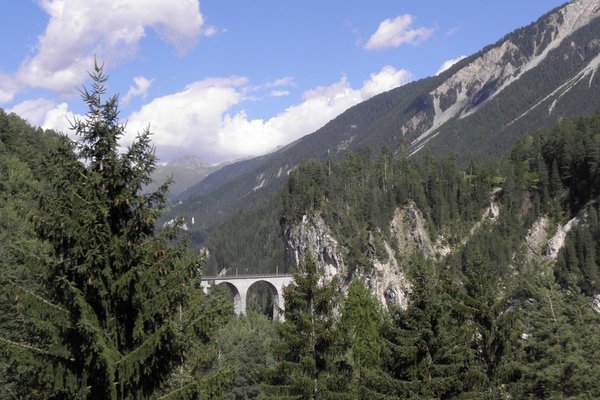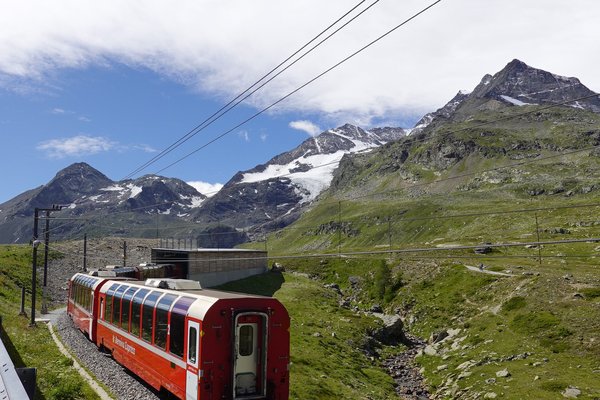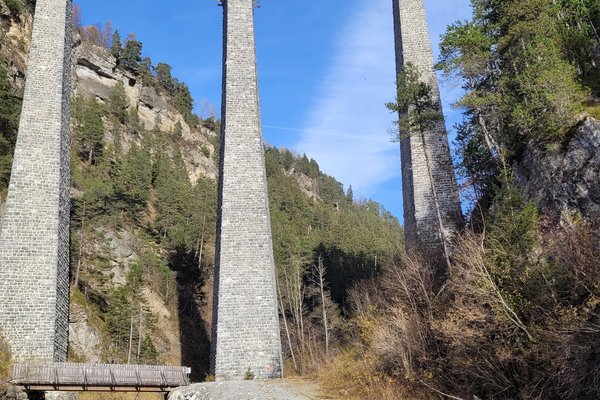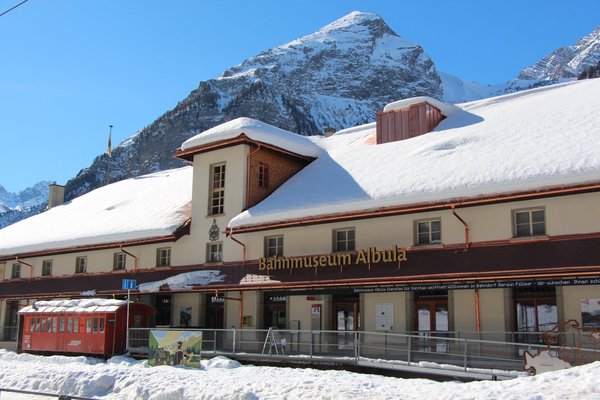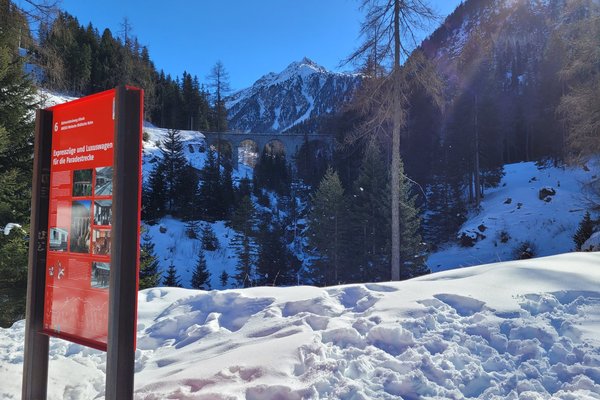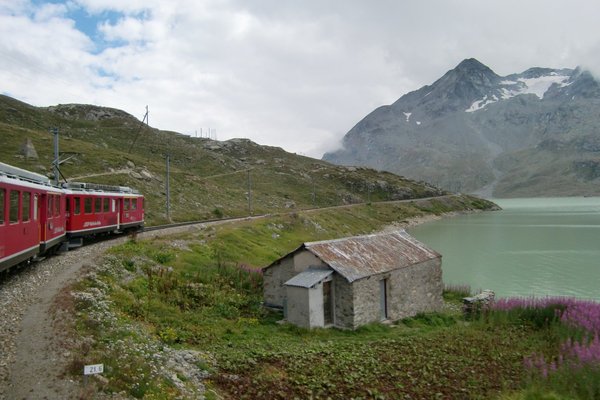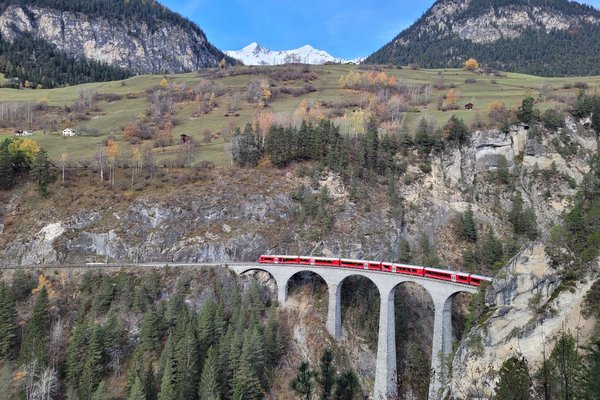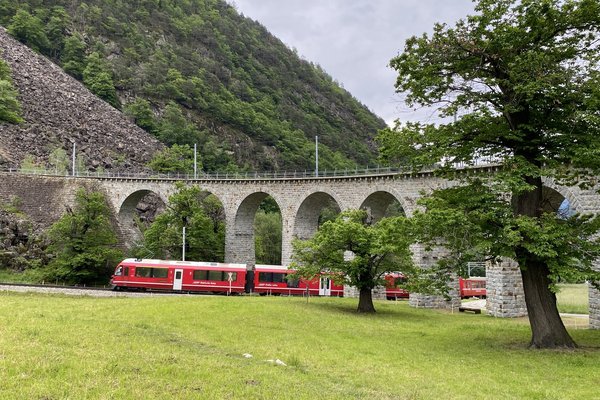Italy, Switzerland
Rhaetian Railway
The Rhaetian Railway in the Albula / Bernina Landscapes consists of the Albula and Bernina transalpine railway lines, noted for their technical quality.
The lines were built from 1908-1910. The Albula line leads from Chur to St. Mortiz, and the Bernina line leads from St. Moritz to Tirano across the border in Italy. Along the way, numerous tunnels, viaducts and bridges had to be built. The railway was designed to follow an existing mountain road.
Community Perspective: You obviously have to do this by riding the train – it still is an active railway line. The structures of interest (viaducts, bridges) however are difficult to see from the train; among these, the Landwasserviaduct is a highlight.
Site Info
Official Information
- Full Name
- Rhaetian Railway in the Albula / Bernina Landscapes (ID: 1276)
- Countries
- Italy Switzerland
- Status
-
Inscribed 2008
Site history
History of Rhaetian Railway
- 2008: Inscribed
- Inscribed
- Type
- Cultural
- Criteria
- ii
- iv
Links
- UNESCO
- whc.unesco.org
- Official
-
- rhb.ch — Official Rhätische Bahn
- Related
-
- ebepe.com — Extensive collection of photos
All Links
UNESCO.org
- whc.unesco.org — whc.unesco.org/
Official Website
- rhb.ch — Official Rhätische Bahn
Related Resources
- ebepe.com — Extensive collection of photos
Community Information
- Community Category
- Human activity: Transport and Trade
Travel Information
Lombardy hotspot
Recent Connections
-
Perfect Inscriptions
2008 -
Depicted in Mizielinska Maps
Landwasser ViaductSee i.pinimg.com
-
Ramsar Wetlands
Vadret da Roseg
Connections of Rhaetian Railway
- Geography
- Trivia
-
-
Depicted in Mizielinska Maps
Landwasser ViaductSee i.pinimg.com
-
Olympic Venues
The remarkable role played by the region of Saint-Moritz in the creation and development of winter sports was recognised when the first Winter Olympic games were held there in 1928, and subsequently in 1948. (Unesco website)
-
- World Heritage Process
- Constructions
-
-
Hydro Power Stations
Section 2b7 of the Nomination File is titled "Power for the Albula and Bernina line: the power station buildings along the railway line" Because of the site's "strange" use of different "levels" of "Buffer zones" (Primary Buffer Zone, Buffer Zone in "Near" area and Buffer Zone in "Distant" Area or "back drop") which actually contribute towards the OUV it is not possible to identify within the Nomination file exactly which zone the various power stations reside in! -
Tunnels
-
Railways
-
- WHS on Other Lists
-
-
Ramsar Wetlands
Vadret da Roseg
-
- Timeline
-
-
Built in the 20th century
1908-10
-
- WHS Hotspots
-
-
Lombardy hotspot
Tirano is 2.5h from Milan
-
- WHS Names
-
-
Roman Province in its official title
Rhaetia . Created 15BCSee en.wikipedia.org
-
News
No news.
Recent Visitors
Visitors of Rhaetian Railway
- Adam Hancock
- Adrian Turtschi
- Afshin Iranpour
- Alexander Barabanov
- Alexander Lehmann
- alicemears
- ALS
- Alvaro1404
- A. Mehmet Haksever
- Anna Wludarska
- Antonio J.
- Argo
- Aspasia
- Astraftis
- Atila Ege
- AYB
- BaziFettehenne
- Bill Maurmann
- Bin
- BJGreasly
- CampbellME
- Can SARICA
- Caspar
- chenqtao
- CherylKla
- Cholden324
- Christian Wagner
- christof
- Christoph
- Christravelblog
- Claire Bradshaw
- Clyde
- Cristina Erba
- cwthong
- Daniela Hohmann
- Daniel Chazad
- Daniel Gabi
- Dan Pettigrew
- David Berlanda
- David Marton
- Deffra
- Dimitar Krastev
- Dirk-pieter
- DjhMck
- Dorejd
- Elia Vettorato
- Elliot
- Els Slots
- Emilia
- Eric Lurio
- Erik G
- Erik Jelinek
- Errol Neo
- Eva Kisgyorgy
- fabi-ddorf
- Fan Yibo
- Farinelli
- Feldhase
- Flexiear
- Frederik Dawson
- Gary Arndt
- Geert Luiken
- GeorgeIng61
- GerhardM
- HaraldOest
- Harald T.
- Harry Mitsidis
- Hasco
- Iain Jackson
- Ian Cade
- ih0000
- Ivan
- Ivan Rucek
- Jakob F.
- James Bowyer
- Janina Lehmann
- Janos
- Jarek Pokrzywnicki
- Jasam
- Jay T
- jballard650
- Jean Lecaillon
- Jeanne OGrady
- Jeffrey Chai
- Jens
- Jesse S 2010
- Jezza
- JL
- JobStopar
- Joel on the Road
- Jonas Kremer
- Jonas Martinsson
- Joyce van Soest
- Karito Vies
- Kbecq
- Kerékgyártó
- Kevin Padley-Knight
- Klaus Freisinger
- KreneH
- Krijn
- La Concy
- Lara Adler
- LaVale
- Lisu Marian
- Loic Pedras
- Lucas Del Puppo
- Lucio
- Luis Filipe Gaspar
- Luj3904
- Maciej Gil
- Mahuhe
- Manuelfunk
- marc Rouserez
- Marie
- Martinacurra88
- Martina Rúčková
- Marton Kemeny
- Marty
- MaYumin
- mg:1
- MichaelH
- Mikko
- Milan Jirasek
- MMM
- Monica Tasciotti
- MoPython
- nan
- Nasebaer
- natlefebvre@hotmail.
- NH1984
- Nihal Ege
- PabloNorte
- Paola Laura
- Patrik
- Patrik_globe
- Paul Schofield
- Peltzi
- PeterA
- Philipp Leu
- Philipp Peterer
- phillipmeng
- Piotr Wasil
- Porcho
- qwertzlbry
- Ralf Regele
- Randi Thomsen
- Reza
- Rick Ohm
- Roger Ourset
- Roman Bruehwiler
- Roman Raab
- Rudegirl
- Schnitzel
- Sergio Arjona
- Shandos Cleaver
- SirLoydd
- Slavi
- Solivagant
- Stanislaw Warwas
- Stefan A. Michelfeit
- Stefan Loov
- Stijn
- Svein Elias
- Szabolcs Mosonyi
- Szucs Tamas
- Taotao Chen
- Tarquinio_Superbo
- Thomas Buechler
- Thomas van der Walt
- Thorben
- tommasorossotti
- tony0001
- Tony H.
- Tsunami
- Twobaconsandaboston
- Vanessa Buechler
- VLabhard
- voyager
- Walter
- wantrain.
- Wimmy
- Wojciech Fedoruk
- wrung24
- Xiong Wei
- Yevhen Ivanovych
- Zoë Sheng
- Александар Стојиљковић
Community Reviews
Show full reviews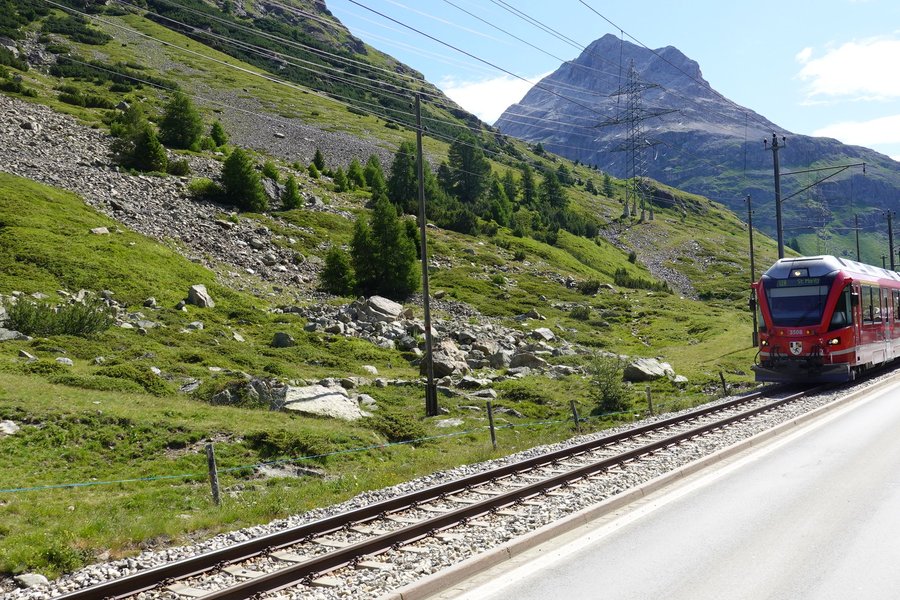
Ask a child to draw a train and they will draw the Bernina Pass train for you.
Everything is there to remind us of our tender childhood and the archetype of electric miniature trains: the railway track, the red locomotive, the tunnels, the bridges, the snow-capped mountain peaks reflected in a lake... the Swiss train that makes us dream in all its splendor!
We had already crossed the Bernina Pass once when we went to Italy in 2019. In Tirano, after having to let the red train pass in front of us on the road like a common tram and not at a conventional level crossing, I swore to myself that I would come back because I found it so strange that a train could take a street normally reserved for cars in any other place.
Beyond that, among the Alpine passes I know, the Bernina Pass is, in my opinion, the most beautiful. We had stopped at the parking lot of the pass inn with Wilson I (today's Wilson is Wilson II). From there, a footpath descends to a small lake and a small railway station.
This year, when planning my trip to Tunisia, I thought my first stop would be the Bernina Pass, but I overestimated the distances and stopped early. This wasn't a bad thing because it made me realize the very essence of the site's inscription: the need to open up a region that is difficult to access by train, with all the technical complications that …
Keep reading 0 comments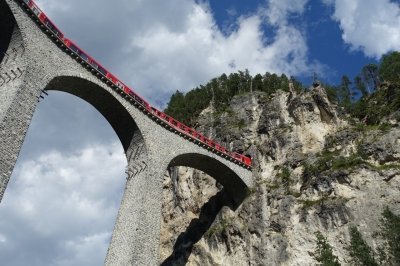
Swiss Rail is known by many for its proverbial punctuality. Having travelled a bit by train in Switzerland, though, to me another feature is the most striking one: It's reach. Swiss trains climb most mountain chains to reach even small rural valleys and remote towns in the backwaters.
Where in most countries trains and public transport in general are a travel option for the less affluent, Swiss Rail to this day seems to be the national mode of travel for all strata of society. Just check out how many Swiss own a GA (General Abonnement), a full year rail pass, costing 3800 CHF in 2nd class.
In a country so infatuated with railways I think the inclusion of the single most iconic railway of the country is a worthwhile addition.
How to Visit
I have to concur with previous reviewers' statements: It's a bit hard to appreciate the site from the train window. While you get nice views of the scenery, you don't see much of the engineering feats. However, you can hop on and off the train and hike from one station to another. There is yet another Swiss heritage trail running from Thussis to Tirano that you can join at any station.
I only covered a small portion of it at Filisur but it included the famed Landwasser Viaduct. If you have some time (I didn't) I would probably hike from the Viaduct to Bergün where the Albula Train Museum …
Keep reading 0 comments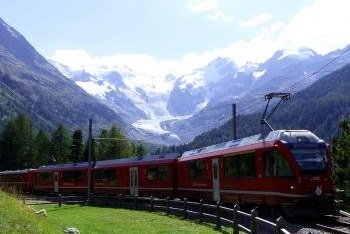
In Sept 2016 we spent a few hours driving the c125kms from Tirano to Thusis across the Bernina and Albula Passes, stopping along the way to see various aspects of the Rhaetian Railway. My general impression was that the Bernina section provided the better “scenery” and the Albula section the more interesting/accessible “railway engineering”. Overall the site passes through some fine, albeit “typical”, Alpine scenery and in some parts contains some interesting, even spectacular, (if not “unique”) railway engineering. Its boundaries, OUV, and even its title, also provide interesting examples of the subtleties and compromises involved in defining a “World Heritage Site”. I explore these below.
The Bernina section commences in what we felt was the disappointing town of Tirano. The metre gauge RhB station sports a UNESCO plaque but is totally without architectural interest. A few very modern trains sat at the modern platforms and the town was full of tourists milling around or having lunch between Rhaetian trains. It turns out that the 3kms section between here and the Swiss border was only added to the nomination during its later development after Italy, never a country to miss a chance of getting another WHS, made “diplomatic” contact with Switzerland to get the section added! (See - http://www.provinea.it/index.php?sezione=candidatura_ferrovia )
For a few kms the line runs along the road itself. The Nomination File makes much of this “It is rare for European railways to run on roads through towns like the Bernina Railway does. Overseas, this …
Keep reading 0 comments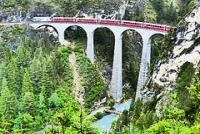
I visited this WHS in June 2014. After spending quite a lot of money to visit other Swiss WHS and mostly because on the day it wasn't sunny, I decided to visit the main train stations and scenic points of the Albula and Bernina passes by car. Considering the many tunnels involved, I think that this approach let me see much more than what I would have seen on the train and I could read the different information boards and take photos at leisure instead of seeing the sites for some split seconds on the Bernina Express. The main railway sights are Rothenbrunnen, the Solisviaduct, Pontresina, Morteratsch, Lago Bianco in Ospizio Bernina, Valposchiavo, the "round viaduct" of Brusio and the Landwasserviaduct. The latter was definitely my favourite and the true highlight of my road trip through mountain passes. From the Filisur train station, there's a short hike to a panoramic point over the Landwasserviaduct and a longer hike beneath it with a number of information boards along both ways. In the future I might be tempted to take the Glacier Express instead of the Bernina Express which costs around 100 euros for the return trip from Chur to Tirano.
Keep reading 0 comments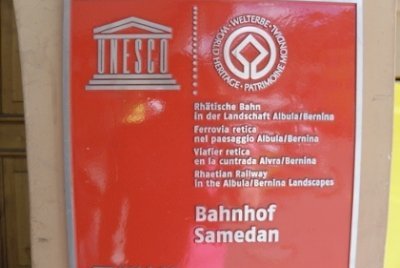
After having visited Mustair, I drove across another mountain pass: the narrow and winding Albula pass. I wondered if it follows the same stretch as the railway line. I saw some tracks and stations, but none of the remarkable engineering works.
I had to try riding a train on this railway of course. So I parked my car in Thusis, and bought a return ticket to St. Moritz. This covers the designated part of the Albula line. I travelled in the regular regional express train, which leaves every hour for the 1.5-hour stretch. The plus side of this train is that the windows can be opened, so you can get better photos. If you know what to take photos of, that is.
I had printed the Albula part of the nomination dossier and tried to follow the route on paper while I was on the train. But to be honest - the objects mentioned are difficult to see from the train. At first, the only things I noticed were the numerous tunnels. One sits in the dark for almost half of the time! The icon of this line is the Landwasser Viaduct, and fortunately, it was announced by the conductor when we were almost there. So I could get a good look at it and take some photos.
The remaining technical highlights en route I found difficult to appreciate from the train. So I was a bit disappointed with the "experience" in general.
Keep reading 0 comments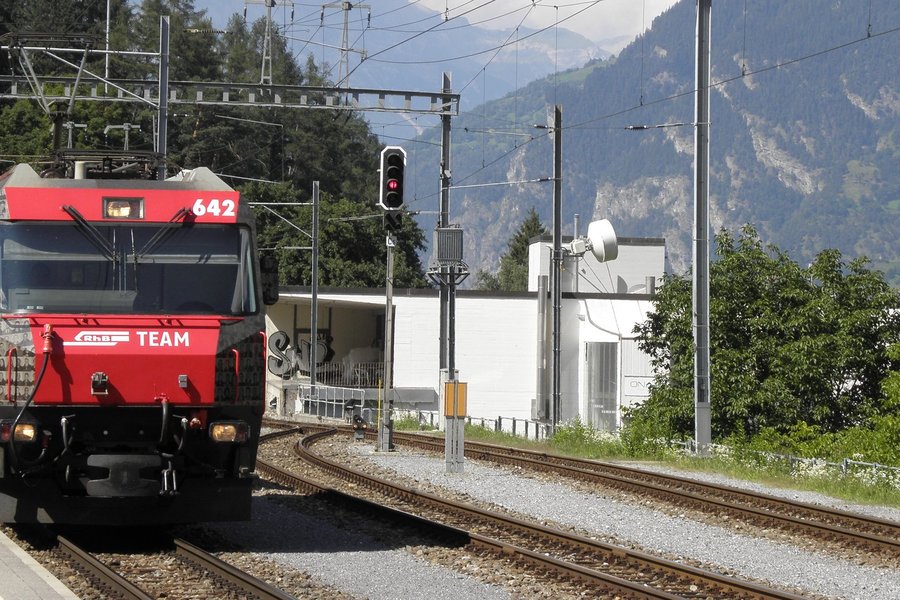
This is really a fantastic site not only for WH collectors, but for anyone who enjoys travelling by train and admiring scenic landscapes. After visiting the WH-listed convent at Müstair, I got on the Bernina line at Pontresina (from Müstair, take the bus to Zernez and continue by train) and took a southbound train to Tirano, just across the border in Italy. Tirano is quite a pretty town, with a famous pilgrimage church and the unique sight of a train passing right through the streets and squares. The next day, I took the same route back and continued until St. Moritz, where I changed into the Albula Train to Chur (the WH part only stretches to Thusis, but trains continue without the need to change). The lines were inscribed as a masterpiece of engineering, and rightly so. There is an endless line of bridges, tunnels, and viaducts, and the Bernina line is one of the steepest railway lines in the world, and one of the few that crosses the Alps not through a tunnel, but goes over a pass (at Ospizio Bernina, which is the highest point of the line at 2,250 metres). Technical features aside, the lines pass through a sequence of varied and beautiful landscapes (including a glacial lake that was still covered with ice in late May) and through German-, Romansh- and Italian-speaking regions, which makes for interesting linguistic diversity. Technically speaking, the Rhaetian Railway is a network covering all railway lines in the Canton of Grisons …
Keep reading 0 comments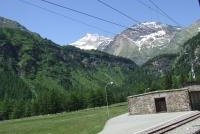
My journey from Milan to Chur took place on a perfect clear day. Starting out early from Milan Centrale the train skirted the east shore of Lake Como and then entered the terraced, vine clad Val Tellina which led to Tirano on the Swiss border.
Here I left the Italian station and walked next door to the Swiss one. People were queueing here to take the expensive Bernina Express, but I took the empty regional train, better because it is cheaper and the windows open for taking photographs.
After travelling through the streets of Tirano the train crossed the border and started the scenic climb around spirals, over bridges, through tunnels and across viaducts to reach the Bernina Pass. At this altitude the scenery was of mountains, glaciers, lakes, streams and a carpet of wild flowers.
Descending to Thusis the line then levelled out and the Sardona peaks came into view as we approached Chur.
Keep reading 0 comments
We started our journey with Bernina Express from Davos so we missed the famous Landwasser viaduct near the town of Filisur. But there were still a lot to see. Between Davos and Filisur the best views were at the Wiesen station. Between Filisur and Bergün the train passed many tunnels and when you're out of the tunnels you can watch the scenery of the valley.
After Bergün the train comes to Albula viaduct. The rails make many spirals in the tunnels and you will lost coordination and wonder which side of the valley you will come out next. After Preda the train goes in to the long Albula tunnel.
The train comes out of the tunnel in the village of Spinas and passes the towns of Bever and Samedan and then comes in to the Bernina valley. At Morteratsch station you can see the Morteratsch glacier - but only if there is good weather and gladly we had that. After that the train starts to climb to the Bernina Pass. At Ospizio Bernina station the railway is on its highest peak. Next to the station is the amazingly blue Lago Bianco.
After the train leaves the Lago Bianco behind you can see the magnificent view of Palü glacier. From Alp Grüm station is the perfect view to the glacier and to the Palü lake. The tunnels along the way made photographing hard, though!
After many turns the train reaches Poschiavo valley. Views from the slopes to the valley are once …
Keep reading 0 comments
